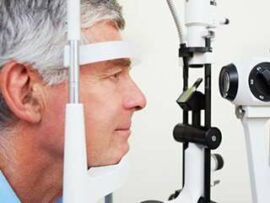Posted by:
Eyes on Rosemont
in Age-Related, Common Eye Conditions
As we age, our eyes—like the rest of our bodies—begin to lose flexibility and strength. When this happens to the lens of the eye and its surrounding muscles, your lens will become stiff. This makes it harder to see close objects clearly because the eyes can’t focus properly. It’s a natural part of aging that […]
Read
More
Posted by:
Eyes on Rosemont
in Cognitive and Acquired, Common Eye Conditions
The condition known as a macular hole refers to a tiny break in the macula that results in blurry or distorted vision. To fully understand the condition, one must understand eye anatomy. The macula is a spot located in the center of the retina (the back portion of the eye). Located where light comes to […]
Read
More
Posted by:
Eyes on Rosemont
in Cognitive and Acquired, Common Eye Conditions
Nystagmus is a vision condition characterized by repetitive, uncontrolled eye movements. These involuntary eye movements may be side-to-side, up and down, or in a circular pattern, which hinders the eyes’ ability to focus on a steady object. Individuals with nystagmus may hold their heads in unusual positions or nod their heads in an effort to […]
Read
More
Posted by:
Eyes on Rosemont
in Common Eye Conditions, Vision Impairment
Color blindness, also known as color vision deficiency, occurs when an individual cannot distinguish between certain colors like red and green or, less commonly, blue and yellow. Cause of Color Blindness Light-sensitive tissue, the retina, lines the back of the eye and consists of two types of light distinguishing cells: rods and cones. While rods […]
Read
More
Posted by:
Eyes on Rosemont
in Common Eye Conditions, Vision Impairment
Most people classified as blind still retain some ability to see. They often have significantly impaired vision but can discern light, shapes, or other figures. Low vision refers to a class of visual impairment that cannot be corrected by glasses or contact lenses. A number of conditions may cause low vision, and actual visual abilities […]
Read
More
Posted by:
Eyes on Rosemont
in Common Eye Conditions, Injury & Irritation
Acanthamoeba keratitis is a relatively rare type of eye infection, but it can become quite serious. If left untreated, Acanthamoeba eventually leads to vision loss, requiring a corneal transplant to restore sight. Understanding how to prevent this infection is key. What Is Acanthamoeba Keratitis? Acanthamoeba is a type of microscopic, single-celled organism known as an […]
Read
More
Posted by:
Eyes on Rosemont
in Common Eye Conditions, Injury & Irritation
The cornea is present as a clear tissue that is located at the front of the eye. A corneal ulcer occurs when there is a sore in the layer of the cornea. Symptoms of this include redness, drainage, visual disturbances, sensitivity to light, itching and discomfort. Causes and Effects of Corneal Ulcers The most common […]
Read
More
Posted by:
Eyes on Rosemont
in Common Eye Conditions, Injury & Irritation
Conjunctivitis, also known as pink eye, is a common eye problem that can afflict children and adults alike. It is highly contagious and spreads quickly in environments like classrooms or offices filled with multiple people in close proximity to one another. The good news is that conjunctivitis is easily treated and can be prevented. Conjunctivitis […]
Read
More
Posted by:
Eyes on Rosemont
in Common Eye Conditions, Injury & Irritation
Seeing a spot or a flash of light in your field of vision is more than an inconvenience. It could be the first signs of a detached retina. A retina becomes detached when separated from underlying layers of support tissue. Detached retinas will lead to a permanent loss of vision if they are not quickly […]
Read
More
Posted by:
Eyes on Rosemont
in Common Eye Conditions, Injury & Irritation
Ocular rosacea, an inflammation of the eye and/or eyelid, occurs in conjunction with rosacea of the skin. A chronic inflammatory condition, rosacea primarily affects the face, cheeks, forehead, and chest area. When rosacea affects the eyes and/or eyelids, the condition is known as ocular rosacea. Ocular Rosacea Symptoms Ocular rosacea primarily occurs in conjunction with […]
Read
More










